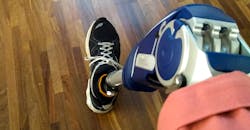Personalized Prosthetic Liners Could Help Amputees Walk again
More than 45,000 people in England alone use prosthetic limbs, with more than 5,000 people each year having new lower-limb amputations. For these individuals, the interface between their residual limb (the amputation site) and their artificial limb is critically important for maintaining healthy, active lives. A good fit between prosthetic and patient can and also could make the difference in whether or not they walk again. To ensure a good, healthy fit, researchers at the University of Bath have developed new ways of designing, manufacturing, and monitoring customized prosthetic liners (pads) in less than a day.
Following an amputation, a person’s residual limb constantly changes in shape and size during the healing process, which can last between 12 and 18 months. This can result in the liner fitting poorly in the long run, leading to tissue damage and causing pain and discomfort for amputees. This is exacerbated by patient activity levels and environmental conditions such as hot weather. The discomfort can lead patients to abandoning their prosthesis and rehabilitation regime, instead being forced to rely on a wheelchair.
This project, drawing on the expertise of a multidisciplinary team of researchers from the University of Bath’s Dept. of Mechanical Engineering, Dept. for Health, and Centre for the Analysis of Motion, Entertainment Research, and Applications (CAMERA), is a new approach to providing liners which fit inside the prosthetic socket that attaches to the artificial leg. It will leverage advances in computer science with an innovative manufacturing process to create affordable new personalized prosthetic liners.
Amputees must currently return to their National Health Service (NHS) prosthetist every time their limb changes size for their socket to be replaced or adjusted. This can happen many times in the first year following amputation. By providing a series of personalized liners of different sizes that all fit within the same prosthetic socket, patients do not have to go to the clinic as often, thus improving patient well-being and saving the NHS time and money.
To make the liners, healthcare personnel use a scanner to quickly capture the precise 3D shape of the amputee’s residuum. The scanned data is used to create a digital model of the residuum which is subsequently used to design the personalized liner. The liner is made using a cryogenic machining technique, so there’s no need for complex and time-consuming molds.
At Bath, the researchers make the line out of a soft polymer neoprene-like material, similar to the material used in wetsuits. It has been found to be more comfortable that the silicon liners currently used by the NHS. The entire process takes less than a day from scanning right through to the physical liner being fitted.
To test the new liner in trials, researchers placed pressure sensors inside the socket to check the line’s fit and used motion capture technology to monitor the patient’s gait. The pressure sensors allow doctors to see if the pressure is too high, which could cause skin damage. Monitoring the gait lets researchers check that the movement of the lower limbs is symmetrical. They also measure the patient walking across force plates to ensure there is no overloading in the knee, ankle, or hip joints.

